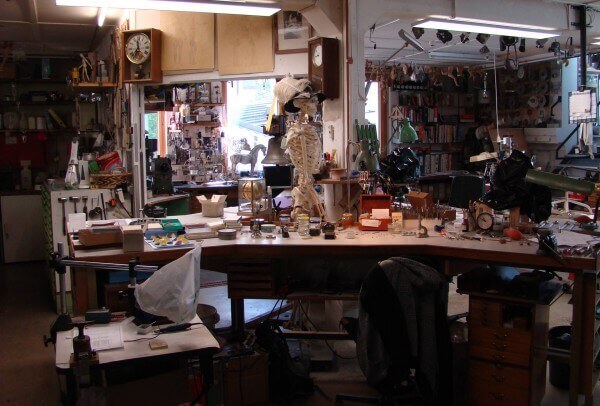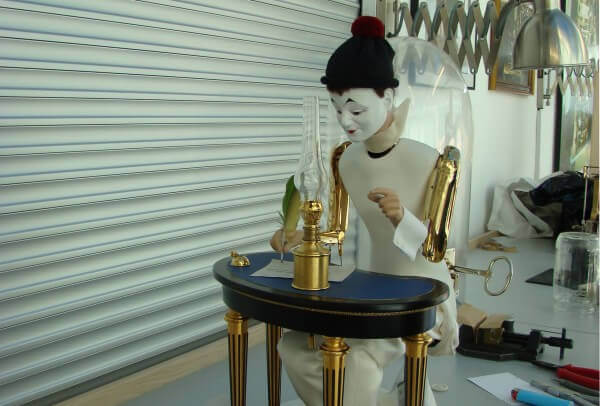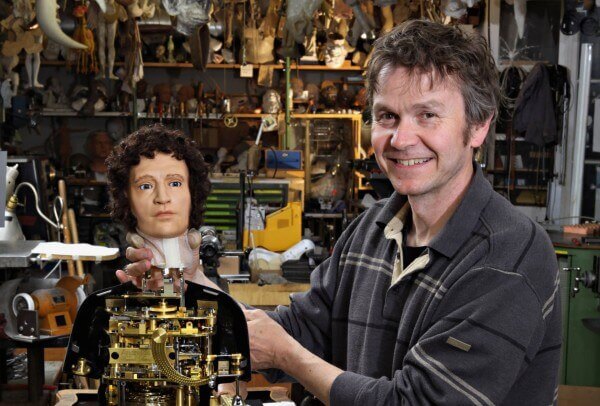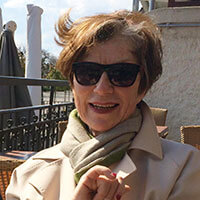The interview takes place on the third and top floor of the studio, where we settle into a pair of leather armchairs, like the well-stuffed seats of a 1950s Cadillac. On the wall, a cut-out of Magritte’s man in a bowler hat adds a surreal touch to a room where angels, one of the many “works in progress”, already hover in a shaft of light from the windows. Wearing his fifty-some years well, François Junod has eyes that sparkle and enthusiasm to spare. Words tumble from his mouth, hardly the image one has of a man whose life revolves around precision mechanics. Had he not discovered art, he says with a smile, he would have stayed in the same job, performing the same tasks. He recalls the years spent at the Fine Arts School in Lausanne (now Ecal), his next stop after training as a micro-mechanical engineer, and how this opened up a whole new world of music, dance, painting and drawing. “I started drawing and couldn’t stop!” A frustrated left-hander, he uses both hands with equal ease, “although I was set free when I realised my right hand was more of an artist than the left and a more attentive observer,” he adds, somewhat cryptically.
There's something magical, wizardly almost, about automatons, starting with the Ancient Egyptians' sand-driven devices through which the divinities were materialised.
Junod, the automaton-maker
“It soon occurred to me that I should do something no-one had done before,” he says, still genuinely modest. His student days in Lausanne, where rents were too high, and Paris, where his hopes of becoming a sculptor never materialised, behind him, news that a workshop had come free in Sainte-Croix brought him back home. For the first seven years he worked alone: “I was a lot less sociable back then.” His reputation grew as did demand. “In Switzerland, things could have been a lot better. Fortunately the Japanese were huge fans.” As he finished one order, another came in, including for a replica of a model made by Jaquet-Droz in 1774 that would be Junod’s first collaborative project. “You get used to sharing,” he confesses. “The first people I worked with tended to be artists; now they’re more likely to come from watchmaking.” The vast, second-floor workshop is divided into five areas, each corresponding to a highly particular specialisation, including restoration of rare mechanisms.

François Junod’s self-confessed fascination with kinetics inspired him to reconstitute, frame by frame, images taken by the late nineteenth-century English photographer Eadweard Muybridge, the first person to break down movement, including horses in motion, and capture it on film. Every corner of the workshop is filled with animated sculptures, as though an army of Giacometti figures had suddenly broken free of their pedestals. “There’s something magical, wizardly almost, about automatons, starting with the Ancient Egyptians’ sand-driven devices through which the divinities were materialised.” The first European automatons, including those by Jaquet-Droz, appeared in the eighteenth century and, as Junod reminds us, roused the disapproval of the Catholic church.
Twelve years for a Stradivarius
One of his earliest dreams was to build an automaton that could both write and draw. “Don’t get your hopes up, kid,” warned automaton-restorer Michel Bertrand. Junod soldiered on regardless. “It took me twelve years but I got there in the end. Like for a Stradivarius. In my opinion, the most perfect androids are those which are able to write or draw as well as we can. They can do something for us, instead of us.”

Tired of travelling back and forth between Switzerland and Japan, François Junod found new openings in the watch industry, notching up a raft of patents in the process. The signing machine he made for Jaquet Droz is one example. He revels in transforming old techniques into new ideas, which has prompted collaborations with Lausanne’s federal institute of technology (EPFL), researching new materials and inertia calculations, and with the Swiss centre for electronics and microtechnology (CSEM), among others. “This is a golden age for automatons, as computers mean we can put ideas into practice much faster and with greater precision.” His one regret is that 3D printing should wipe out many of the traditional crafts. “We’ll no longer need a jeweller to transform a design into the finished piece. For anyone not in robotics, it’s going to be tough.”
This is almost a contradiction in terms, coming from someone for whom drawing is an essential stage in the creative process. “I never stop. Sometimes I come across a sketch from ten years ago, tucked away in a drawer.” He is convinced a computer could never capture the ideas forming in his imagination: “I can’t draw with a mouse.” There’s no knowing when inspiration might strike, either: a visit to a museum in Basel gave him the idea to combine an eighteenth-century snuffbox with a magician’s table from which birds appear and disappear.
The pianist Sylvie Courvoisier, who is a close friend, and I spent a long time working on an idea for the very first automaton to play a piece of contemporary music.
Contemporary works
Unexpectedly, the revival in interest in automatons has come from the world of high-tech. Junod tells how his Pushkin automaton was commissioned by a Silicon Valley entrepreneur, who developed the program which determined the 24 words from which Junod’s mechanism makes a random selection to compose 1,459 different poems. At one point, the automaton-maker was even tempted to leave Sainte-Croix and relocate “across the pond”, though the lure of California’s shores ultimately proved less than that of the Alpine nation.

François Junod now sees himself turning towards more contemporary works. “The pianist Sylvie Courvoisier, who is a close friend, and I spent a long time working on an idea for the very first automaton to play a piece of contemporary music. The project is ready and we would love to bring it to life.” Patrons of the arts, take note! Another project close to his heart is for a procession of automatons, similar to the one commissioned by the town of Leganés, in 2006. A team of ten worked non-stop over twenty-four months to produce a parade of life-size figures that includes a Spanish dancer, children and a horse. “I’d love to do the same thing again, but in a more modern, more personal style.” François Junod likes the idea of automatons out in the open, where everyone can see them, particularly children. “The magic works every time. They watch in awe, and never think to ask how much it costs.” What would he make if he were cast away on a desert island for ten days? “A sculpture driven by water and wind. Maybe a wheel made out of palm leaves that turn like propellers to pump water. I love mobiles, and I’d really like to do something with water!”.















